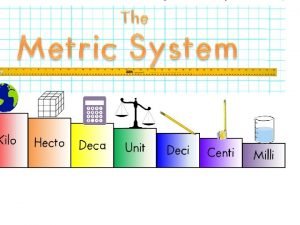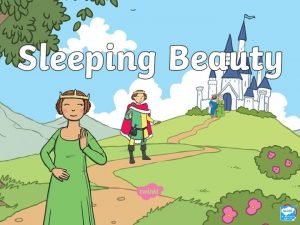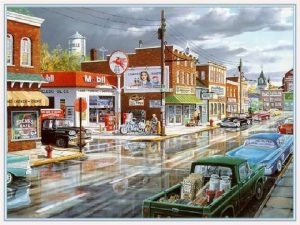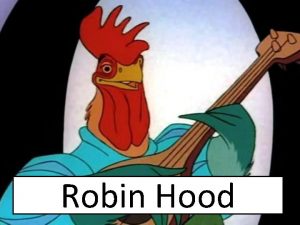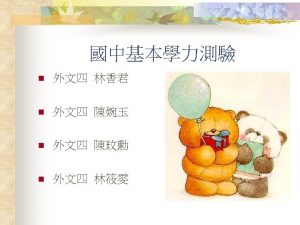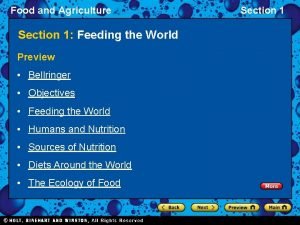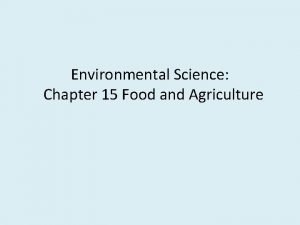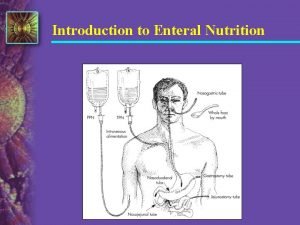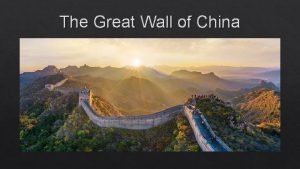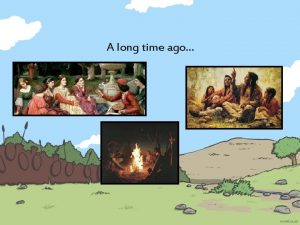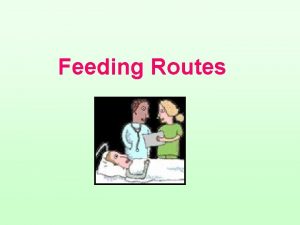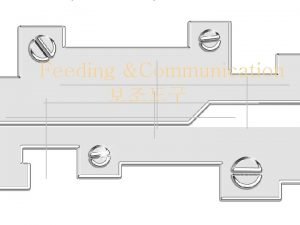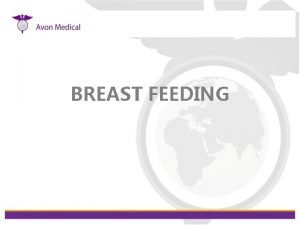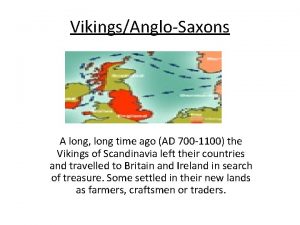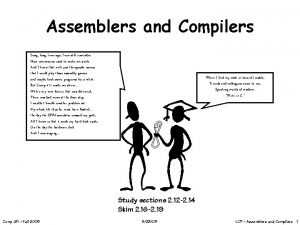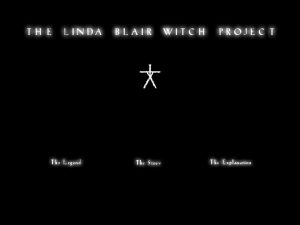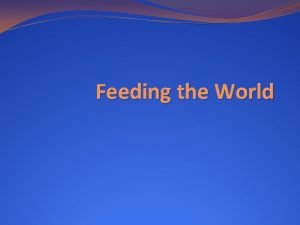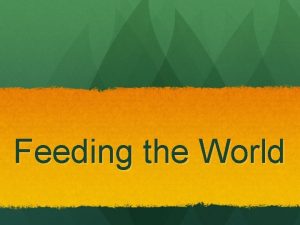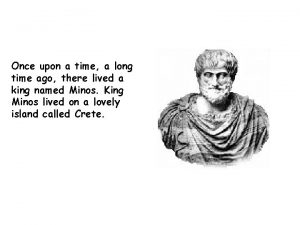Feeding the World A long time ago So





















- Slides: 21

Feeding the World

A long time ago…

So what happened

• Now 21 % of the Earth’s land is currently cultivated and grazed.

Did agriculture fix everything? • In 2009, 1 billion people lacked access to adequate amounts of food.

Nutritional Requirements • Undernutrition (chronic hunger); not consuming enough calories to be healthy. • Effects: improper brain development and lower IQ (just 100 -400 Kilocalories less than daily need) • Calories not the only issue: – According to WHO 3 million people (half world’s population) are malnourished. – Food security vs. food insecurity

Food Insecurity • Famine: condition where food insecurity is so extreme that large numbers of deaths occur in a given area over a short period of time. • What could cause famine? • 250, 000 kids become blind each year from vitamin A deficiency. • 3 million anemic people in the world. • Marasmus: nutritional deficiency which involves both lack of calories and lack of proteins.

Why malnutrition? • We grow enough food to feed 8 billion people. (our population 7 billion). Why are folks still going hungry? – Poverty (food not accessable) – Political and economic factors. (refuges, poor gov’t regulation= wars and unrest) – Used to feed livestock and poultry. (40% of US grain)

Food Security • Overnutrition: 1 billion people are overweight and roughly 300 million are obese. (20% over their ideal weight) • Worldwide there are 50, 000 edible plants but just three constitutes 60% of human energy intake. • Meat consumption has increased globally and in the US.

The Green Revolution • Dr. Norman Borlaug: won Nobel Peace Prize for his contribution to increasing the world food supply. • What kind of changes are we talking about? – Mechanization – Irrigation – Fertilizers – Monocropping – Pesticides

Mechanization Pros • More work done quicker = more money Cons • High up front cost • Monoculture is best • Increase energy use = increase pollution

Irrigation Pro Con • Increase crop growth • Transform deserts to prime farm land. • Deplete ground water • Soil degradation (waterlogging and salinization)

Fertilizers Pro Cons • Replenishes lost nutrients from overuse of soil. • Manufacturing = the use of fossil fuels • More likely to be carried off by runoff. • Do not add organic matter to the soil. – Two types • Organic • Synthetic (easier to apply, nutrient content can be targeted to the needs of the farmer, easily absorbed.

Monocropping: Do we need to review?

Pesticides Terms you will hear when talking about pesticides 1. Insecticides 2. Herbicides 3. Broad spectrum 4. Selective 5. Persistent (DDT) 6. nonpersistant Pro Cons • Gets rid of pest • Prevents crop damage • Bioaccumulation with persistent pesticides • Pest developing a resistance • Kills beneficial organisms • Pollute water

The Genetic Revolution

GMO’s : the second Green Revolution • What are they? – Genetically engineered using recombinant DNA by the process of gene splicing.

GMO’s : the second Green Revolution Advantages Disadvantages • Increased crop yield and quality. • Could change pesticide use • Increased profits • So fear but not proven, that human ingestion cause problems. • Effects on biodiversity (modified genes will spread to wild relatives) and useful traits could be lost. • No regulations (if you want to purchase NO GMO’s then you can buy “organic”

What about our Proteins? High-Density Animal Farming: CAFO’s (Concentrated animal feeding operations) Advantages • • More product Easier to produce Cheaper More money Disadvantages • Concentrations of pollution problems such as foul smells from fed lots • Contaminations to drinking water by nitrates in animal wastes (also effects vegetables) • Increase in the spread of diseases. • Increase pressure on the world’s grain supply to feed the animals • Increase inputs of energy from fossil fuels

Who’s to blame? • Ignorance (us) • Government Policies – Farm Bill • http: //www. farmbillfacts. org/rallying-for-action-toward-thenext-farm-bill • http: //www. npr. org/templates/story. php? story. Id=158 91678 – Subsidies (keeps food prices artificially low) • http: //www. pbs. org/teachers/access-analyze-acteconomy/curriculum/sugar-supply/the-cultivation-ofagricultural-subsidies#instant-expert

More Sustainable Methods 1. Small scale farming 2. Shifting agriculture (Includes slash and burn) 3. Sustainable agriculture: intercropping, crop rotation, agroforestry, contour plowing/planting 4. No-Till agriculture 5. Integrated Pest Management (IPM) 6. Organic Agriculture: use natural systems, keep as much organic matter in soil as possible, no synthetic fertilizers and pesticides 7. To reduce fertilizer run-off (used prescribe amounts and plant legumes and other nitrogen fixing plants)
 Once upon a time a long long time ago begins the story
Once upon a time a long long time ago begins the story Once upon a long time ago
Once upon a long time ago Once upon a time, there
Once upon a time, there Enteral parenteral beslenme
Enteral parenteral beslenme Long time ago people
Long time ago people Once upon a time stories with kings and queens are
Once upon a time stories with kings and queens are Greek
Greek Since long time ago
Since long time ago A long time ago in america
A long time ago in america Once upon a time long ago and far away
Once upon a time long ago and far away A long time ago there
A long time ago there A long time ago there
A long time ago there My dear do you know how a long time ago
My dear do you know how a long time ago Once upon a time long ago and far away
Once upon a time long ago and far away Since long time ago
Since long time ago Long and short
Long and short Từ ngữ thể hiện lòng nhân hậu
Từ ngữ thể hiện lòng nhân hậu Section 1 feeding the world
Section 1 feeding the world Active reading feeding the world
Active reading feeding the world Open system tube feeding hang time
Open system tube feeding hang time Great wall
Great wall Akkadians long ago conquered sumer took control
Akkadians long ago conquered sumer took control




